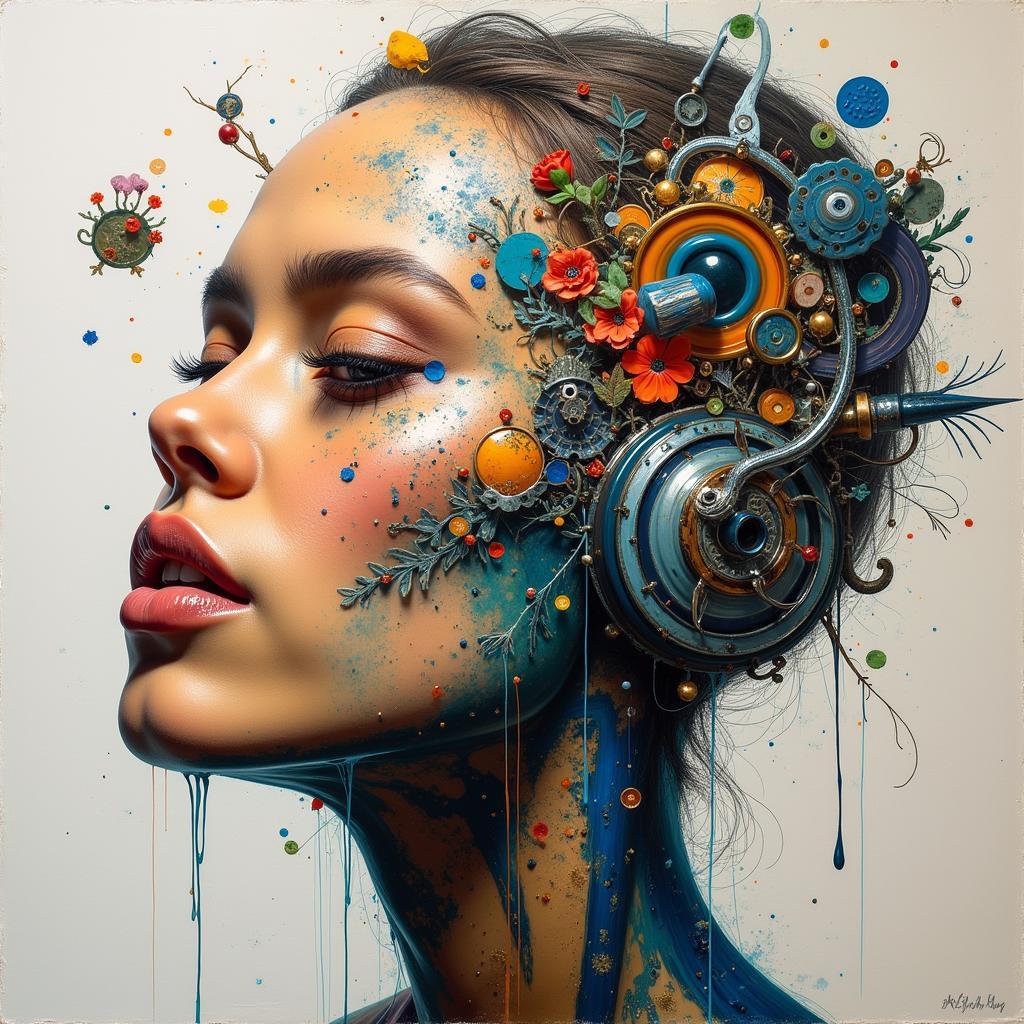Abstract Art vs Realistic Art: Exploring Two Worlds of Artistic Expression
Abstract and realistic art represent two fundamentally different approaches to visual expression. While realistic art strives to mimic the world around us, abstract art ventures into the realm of emotions, concepts, and interpretations, often abandoning recognizable forms. This exploration delves into the fascinating differences and surprising connections between these two distinct yet interconnected artistic worlds.
One of the most significant distinctions between abstract and realistic art lies in their objectives. Realistic art aims to capture the world as accurately as possible, prioritizing detail and precision. Think of the meticulous brushstrokes of a portrait or the lifelike rendering of a still life. Conversely, abstract art seeks to convey emotions, ideas, or experiences through non-representational forms and colors. It’s about evoking a feeling or a thought rather than replicating a visual reality. Check out some breathtaking examples of fantasy art at masterpieces of fantasy art.
Defining Abstract and Realistic Art
What is Abstract Art?
Abstract art uses colors, shapes, and forms to create compositions that may exist with no visual reference to the real world. It’s often about exploring the pure elements of art – line, color, form, and texture – for their own sake.
What is Realistic Art?
Realistic art, also known as representational art, aims to depict subjects as they appear in real life. This style emphasizes accuracy and detail, striving to create a faithful representation of the observable world.
Key Differences Between Abstract and Realistic Art
The differences between abstract and realistic art extend beyond just the visual. They encompass the artist’s intention, the viewer’s interpretation, and the overall impact of the artwork.
- Subject Matter: Realistic art focuses on tangible subjects, while abstract art often explores intangible concepts and emotions.
- Technique: Realistic art emphasizes precise techniques to achieve lifelike representation, while abstract art allows for greater freedom and experimentation.
- Interpretation: Realistic art often has a more straightforward interpretation, while abstract art invites subjective responses and personal meanings.
For instance, the emotional impact of vibrant color fields in abstract expressionism differs greatly from the detailed depiction of a historical event in a realistic painting. Both are powerful in their own right, yet they communicate through different visual languages. You might appreciate the intriguing blend of styles in art martini.
The Emotional Impact of Abstract vs. Realistic Art
How Does Abstract Art Make You Feel?
Abstract art can evoke a wide range of emotions, from tranquility and contemplation to excitement and unease. The absence of recognizable forms allows viewers to connect with the artwork on a more personal and intuitive level.
How Does Realistic Art Make You Feel?
Realistic art can elicit feelings of awe, wonder, or nostalgia, depending on the subject matter. The accuracy and detail can transport the viewer to another time and place, creating a strong sense of connection with the depicted scene.
 Emotional Responses to Art
Emotional Responses to Art
Exploring Different Styles within Abstract and Realistic Art
Both abstract and realistic art encompass a wide range of styles and movements. Within abstract art, we find movements like Cubism, Surrealism, and Abstract Expressionism, each with its unique characteristics. Similarly, realism includes styles like Photorealism, Impressionism, and Social Realism.
“The beauty of abstract art lies in its ability to unlock the imagination and invite viewers to create their own narratives.” – Amelia Stone, Art Historian
The Intersection of Abstract and Realistic Art
While seemingly disparate, abstract and realistic art are not mutually exclusive. Many artists have successfully blended elements of both approaches, creating works that blur the lines between representation and abstraction. For instance, some artists might use abstract techniques to depict realistic subjects, creating a unique and evocative style. Explore more artistic expressions in art of sexy women.
“Realism provides the foundation, while abstraction offers the freedom to explore beyond the confines of the visible world.” – David Chen, Contemporary Artist
 Blending Abstract and Realistic Elements
Blending Abstract and Realistic Elements
Conclusion
Abstract and realistic art offer unique perspectives on the world, appealing to different sensibilities and evoking diverse emotional responses. Whether you are drawn to the precise detail of realistic art or the expressive freedom of abstract art, both offer a rich and rewarding journey into the world of visual expression. Exploring both abstract and realistic art allows us to appreciate the vast spectrum of human creativity and the power of art to communicate in myriad ways.
FAQ
- What is the main difference between abstract and realistic art? Realistic art depicts the world as it appears, while abstract art uses non-representational forms and colors.
- What are some examples of abstract art movements? Cubism, Surrealism, and Abstract Expressionism.
- What are some examples of realistic art styles? Photorealism, Impressionism, and Social Realism.
- Can art be both abstract and realistic? Yes, some artists blend elements of both approaches.
- Why is abstract art sometimes difficult to understand? Because it focuses on emotions and concepts rather than literal representation.
- What should I look for when viewing abstract art? Focus on the colors, shapes, and textures, and consider the emotions they evoke.
- What should I look for when viewing realistic art? Pay attention to the detail, accuracy, and the artist’s skill in capturing the subject.
Common Scenarios and Questions
- Scenario: A viewer struggling to connect with abstract art. Question: How can I appreciate abstract art if I don’t understand it? Answer: Focus on the emotional response the artwork evokes in you, rather than trying to decipher a literal meaning.
- Scenario: Choosing between purchasing an abstract or realistic artwork. Question: Which style is better, abstract or realistic? Answer: There is no “better” style; it depends on your personal preference and what you want the artwork to convey in your space.
Further Exploration
Explore more holiday-themed art at christmas art for tv and spiritual art at jesus walking on water art.
Contact Us
For any assistance or inquiries, please contact us at Phone Number: 02462573573, Email: danteum@gmail.com, or visit us at Savico Megamall, 7-9 Đ. Nguyễn Văn Linh, Gia Thụy, Long Biên, Hà Nội 10000, Việt Nam. Our customer service team is available 24/7.


